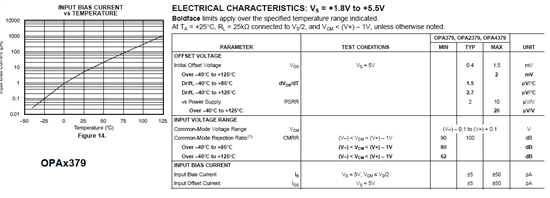With OPA2379, we see a drift which appears to exceed the datasheet specifications.
What is the bias current specification over temperature? Datasheet says maks +-50pA but I think this is only specified at 25 oC. Right?
Are there any specified limits at other temperatures, because figure 14 is only for typical values. Right?
So how do we determine the limits for the bias current at other temperatures than 25 oC?
Her is a discription of our setup and our results:
The circuit is as simple as possible: A transimpedance amplifier with 0 A input current. This is to be taken very literally because the feedback circuit (R||C) is an air-connection. The node connected to the in- pin is in free air. The common mode is thus 1.25V below the Vs as recommended with regards to low offset voltage.
We measure the output voltage versus temperature. This is a measure of the combined input offset and input bias current, and of course any leakage currents which could be there as well. We checked that the circuit is stable. The circuit is in a metal enclosure as the in- node is very sensitive to electric field pickup.
Below 30oC the output voltage is generally below 1mV. But gradually raise to from 3mV to 4mV at 70oC.
Datasheet specifies:
Voffset <2mV over extended temperature range.
Voffset drift is maks 2.7uV/oC => or maks 0.10mV at 40oC change.
Ibias is maks +-50pA at 25 oC => 10Mohm*50pA = +-0.5mV
Ibias variation figure 14: indicate that the bias current should stay below 100pA = 1mV output change. (Is that true?)
So in total this never going to add up to 3 to 4mV. Where is the mistake?
Thanks for any hints you can provide.
Here are the relevant(?) datasheet extracts:



